+ データを開く
データを開く
- 基本情報
基本情報
| 登録情報 | データベース: PDB / ID: 5fwl | |||||||||
|---|---|---|---|---|---|---|---|---|---|---|
| タイトル | Atomic cryoEM structure of Hsp90-Cdc37-Cdk4 complex | |||||||||
 要素 要素 |
| |||||||||
 キーワード キーワード | CHAPERONE / HSP90 / CDC37 / CDK4 / KINASE / UNFOLDING | |||||||||
| 機能・相同性 |  機能・相同性情報 機能・相同性情報cyclin D3-CDK4 complex / cyclin D1-CDK4 complex / cyclin D2-CDK4 complex / Evasion of Oncogene Induced Senescence Due to Defective p16INK4A binding to CDK4 / Evasion of Oxidative Stress Induced Senescence Due to Defective p16INK4A binding to CDK4 / regulation of transcription initiation by RNA polymerase II / regulation of type II interferon-mediated signaling pathway / Evasion of Oncogene Induced Senescence Due to Defective p16INK4A binding to CDK4 and CDK6 / Evasion of Oxidative Stress Induced Senescence Due to Defective p16INK4A binding to CDK4 and CDK6 / Drug-mediated inhibition of CDK4/CDK6 activity ...cyclin D3-CDK4 complex / cyclin D1-CDK4 complex / cyclin D2-CDK4 complex / Evasion of Oncogene Induced Senescence Due to Defective p16INK4A binding to CDK4 / Evasion of Oxidative Stress Induced Senescence Due to Defective p16INK4A binding to CDK4 / regulation of transcription initiation by RNA polymerase II / regulation of type II interferon-mediated signaling pathway / Evasion of Oncogene Induced Senescence Due to Defective p16INK4A binding to CDK4 and CDK6 / Evasion of Oxidative Stress Induced Senescence Due to Defective p16INK4A binding to CDK4 and CDK6 / Drug-mediated inhibition of CDK4/CDK6 activity / regulation of type B pancreatic cell proliferation / HSP90-CDC37 chaperone complex / negative regulation of proteasomal protein catabolic process / Aryl hydrocarbon receptor signalling / aryl hydrocarbon receptor complex / cellular response to ionomycin / dynein axonemal particle / histone methyltransferase binding / Transcriptional regulation by RUNX2 / cellular response to phorbol 13-acetate 12-myristate / receptor ligand inhibitor activity / positive regulation of type 2 mitophagy / ATP-dependent protein binding / positive regulation of protein localization to cell surface / regulation of cyclin-dependent protein serine/threonine kinase activity / protein kinase regulator activity / protein folding chaperone complex / cyclin-dependent protein serine/threonine kinase regulator activity / post-transcriptional regulation of gene expression / Respiratory syncytial virus genome replication / telomerase holoenzyme complex assembly / positive regulation of transforming growth factor beta receptor signaling pathway / Uptake and function of diphtheria toxin / PTK6 Regulates Cell Cycle / Drug-mediated inhibition of ERBB2 signaling / Resistance of ERBB2 KD mutants to trastuzumab / Resistance of ERBB2 KD mutants to sapitinib / Resistance of ERBB2 KD mutants to tesevatinib / Resistance of ERBB2 KD mutants to neratinib / Resistance of ERBB2 KD mutants to osimertinib / Resistance of ERBB2 KD mutants to afatinib / Resistance of ERBB2 KD mutants to AEE788 / Resistance of ERBB2 KD mutants to lapatinib / Drug resistance in ERBB2 TMD/JMD mutants / regulation of type I interferon-mediated signaling pathway / TPR domain binding / dendritic growth cone / Defective binding of RB1 mutants to E2F1,(E2F2, E2F3) / Assembly and release of respiratory syncytial virus (RSV) virions / The NLRP3 inflammasome / protein phosphatase activator activity / Sema3A PAK dependent Axon repulsion / regulation of protein ubiquitination / HSF1-dependent transactivation / response to unfolded protein / bicellular tight junction / cyclin-dependent kinase / HSF1 activation / cyclin-dependent protein serine/threonine kinase activity / axonal growth cone / telomere maintenance via telomerase / protein targeting / Attenuation phase / chaperone-mediated protein complex assembly / RHOBTB2 GTPase cycle / Purinergic signaling in leishmaniasis infection / cyclin-dependent protein kinase holoenzyme complex / supramolecular fiber organization / : / regulation of G2/M transition of mitotic cell cycle / heat shock protein binding / DNA polymerase binding / positive regulation of G2/M transition of mitotic cell cycle / Signaling by ERBB2 / negative regulation of proteasomal ubiquitin-dependent protein catabolic process / peptide binding / protein folding chaperone / cellular response to interleukin-4 / cyclin binding / nitric-oxide synthase regulator activity / placenta development / ESR-mediated signaling / HSP90 chaperone cycle for steroid hormone receptors (SHR) in the presence of ligand / Constitutive Signaling by Overexpressed ERBB2 / Ubiquitin-dependent degradation of Cyclin D / positive regulation of cell differentiation / Hsp90 protein binding / ATP-dependent protein folding chaperone / Signaling by ERBB2 TMD/JMD mutants / G1/S transition of mitotic cell cycle / Constitutive Signaling by EGFRvIII / Signaling by ERBB2 ECD mutants / DDX58/IFIH1-mediated induction of interferon-alpha/beta / Oncogene Induced Senescence / Signaling by ERBB2 KD Mutants / Meiotic recombination / Regulation of actin dynamics for phagocytic cup formation / Transcriptional regulation of white adipocyte differentiation / Regulation of necroptotic cell death / tau protein binding 類似検索 - 分子機能 | |||||||||
| 生物種 |  HOMO SAPIENS (ヒト) HOMO SAPIENS (ヒト) | |||||||||
| 手法 | 電子顕微鏡法 / 単粒子再構成法 / クライオ電子顕微鏡法 / 解像度: 9 Å | |||||||||
 データ登録者 データ登録者 | Verba, K.A. / Wang, R.Y.R. / Arakawa, A. / Liu, Y. / Yokoyama, S. / Agard, D.A. | |||||||||
 引用 引用 |  ジャーナル: Science / 年: 2016 ジャーナル: Science / 年: 2016タイトル: Atomic structure of Hsp90-Cdc37-Cdk4 reveals that Hsp90 traps and stabilizes an unfolded kinase. 著者: Kliment A Verba / Ray Yu-Ruei Wang / Akihiko Arakawa / Yanxin Liu / Mikako Shirouzu / Shigeyuki Yokoyama / David A Agard /   要旨: The Hsp90 molecular chaperone and its Cdc37 cochaperone help stabilize and activate more than half of the human kinome. However, both the mechanism by which these chaperones assist their "client" ...The Hsp90 molecular chaperone and its Cdc37 cochaperone help stabilize and activate more than half of the human kinome. However, both the mechanism by which these chaperones assist their "client" kinases and the reason why some kinases are addicted to Hsp90 while closely related family members are independent are unknown. Our structural understanding of these interactions is lacking, as no full-length structures of human Hsp90, Cdc37, or either of these proteins with a kinase have been elucidated. Here we report a 3.9 angstrom cryo-electron microscopy structure of the Hsp90-Cdc37-Cdk4 kinase complex. Surprisingly, the two lobes of Cdk4 are completely separated with the β4-β5 sheet unfolded. Cdc37 mimics part of the kinase N lobe, stabilizing an open kinase conformation by wedging itself between the two lobes. Finally, Hsp90 clamps around the unfolded kinase β5 strand and interacts with exposed N- and C-lobe interfaces, protecting the kinase in a trapped unfolded state. On the basis of this structure and an extensive amount of previously collected data, we propose unifying conceptual and mechanistic models of chaperone-kinase interactions. | |||||||||
| 履歴 |
|
- 構造の表示
構造の表示
| ムービー |
 ムービービューア ムービービューア |
|---|---|
| 構造ビューア | 分子:  Molmil Molmil Jmol/JSmol Jmol/JSmol |
- ダウンロードとリンク
ダウンロードとリンク
- ダウンロード
ダウンロード
| PDBx/mmCIF形式 |  5fwl.cif.gz 5fwl.cif.gz | 614.9 KB | 表示 |  PDBx/mmCIF形式 PDBx/mmCIF形式 |
|---|---|---|---|---|
| PDB形式 |  pdb5fwl.ent.gz pdb5fwl.ent.gz | 495.7 KB | 表示 |  PDB形式 PDB形式 |
| PDBx/mmJSON形式 |  5fwl.json.gz 5fwl.json.gz | ツリー表示 |  PDBx/mmJSON形式 PDBx/mmJSON形式 | |
| その他 |  その他のダウンロード その他のダウンロード |
-検証レポート
| 文書・要旨 |  5fwl_validation.pdf.gz 5fwl_validation.pdf.gz | 1 MB | 表示 |  wwPDB検証レポート wwPDB検証レポート |
|---|---|---|---|---|
| 文書・詳細版 |  5fwl_full_validation.pdf.gz 5fwl_full_validation.pdf.gz | 1 MB | 表示 | |
| XML形式データ |  5fwl_validation.xml.gz 5fwl_validation.xml.gz | 54.5 KB | 表示 | |
| CIF形式データ |  5fwl_validation.cif.gz 5fwl_validation.cif.gz | 84.4 KB | 表示 | |
| アーカイブディレクトリ |  https://data.pdbj.org/pub/pdb/validation_reports/fw/5fwl https://data.pdbj.org/pub/pdb/validation_reports/fw/5fwl ftp://data.pdbj.org/pub/pdb/validation_reports/fw/5fwl ftp://data.pdbj.org/pub/pdb/validation_reports/fw/5fwl | HTTPS FTP |
-関連構造データ
| 関連構造データ |  3341MC  3337C  3338C  3339C  3340C  3342C  3343C  3344C  5fwkC  5fwmC  5fwpC C: 同じ文献を引用 ( M: このデータのモデリングに利用したマップデータ |
|---|---|
| 類似構造データ |
- リンク
リンク
- 集合体
集合体
| 登録構造単位 | 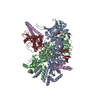
|
|---|---|
| 1 |
|
- 要素
要素
| #1: タンパク質 | 分子量: 83645.539 Da / 分子数: 2 / 由来タイプ: 組換発現 / 由来: (組換発現)  HOMO SAPIENS (ヒト) / プラスミド: PFASTBACHT HOMO SAPIENS (ヒト) / プラスミド: PFASTBACHT発現宿主:  参照: UniProt: P08238 #2: タンパク質 | | 分子量: 44622.363 Da / 分子数: 1 / 由来タイプ: 組換発現 / 由来: (組換発現)  HOMO SAPIENS (ヒト) / プラスミド: PFASTBACHT HOMO SAPIENS (ヒト) / プラスミド: PFASTBACHT発現宿主:  参照: UniProt: Q16543 #3: タンパク質 | | 分子量: 34520.629 Da / 分子数: 1 / 由来タイプ: 組換発現 / 由来: (組換発現)  HOMO SAPIENS (ヒト) / プラスミド: PFASTBACHT HOMO SAPIENS (ヒト) / プラスミド: PFASTBACHT発現宿主:  参照: UniProt: P11802 #4: 化合物 | #5: 化合物 | Has protein modification | Y | 配列の詳細 | N TERMINAL TAG | |
|---|
-実験情報
-実験
| 実験 | 手法: 電子顕微鏡法 |
|---|---|
| EM実験 | 試料の集合状態: PARTICLE / 3次元再構成法: 単粒子再構成法 |
- 試料調製
試料調製
| 構成要素 | 名称: COMPLEX OF HUMAN HSP90BETA, HUMAN CDC37 AND HUMAN CDK4 タイプ: COMPLEX |
|---|---|
| 緩衝液 | 名称: 20MM TRIS-HCL, 150 MM NACL, 10MM KCL, 10MM MGCL2, 20MM NA2MOO4, 2MM DTT, 0.085MM DDM pH: 7.5 詳細: 20MM TRIS-HCL, 150 MM NACL, 10MM KCL, 10MM MGCL2, 20MM NA2MOO4, 2MM DTT, 0.085MM DDM |
| 試料 | 濃度: 0.27 mg/ml / 包埋: NO / シャドウイング: NO / 染色: NO / 凍結: YES |
| 急速凍結 | 装置: FEI VITROBOT MARK III / 凍結剤: ETHANE |
- 電子顕微鏡撮影
電子顕微鏡撮影
| 実験機器 |  モデル: Titan Krios / 画像提供: FEI Company |
|---|---|
| 顕微鏡 | モデル: FEI TITAN KRIOS / 日付: 2014年11月25日 |
| 電子銃 | 電子線源:  FIELD EMISSION GUN / 加速電圧: 300 kV / 照射モード: OTHER FIELD EMISSION GUN / 加速電圧: 300 kV / 照射モード: OTHER |
| 電子レンズ | モード: BRIGHT FIELD / 倍率(公称値): 22500 X / 最大 デフォーカス(公称値): 3800 nm / 最小 デフォーカス(公称値): 1400 nm / Cs: 2.7 mm |
| 撮影 | 電子線照射量: 44 e/Å2 フィルム・検出器のモデル: GATAN K2 SUMMIT (4k x 4k) |
- 解析
解析
| EMソフトウェア |
| ||||||||||||
|---|---|---|---|---|---|---|---|---|---|---|---|---|---|
| 対称性 | 点対称性: C1 (非対称) | ||||||||||||
| 3次元再構成 | 解像度: 9 Å / 粒子像の数: 45974 / ピクセルサイズ(実測値): 1.315 Å 詳細: THIS MODEL WAS BUILT BASED ON 5FWK WITH CDK4 N-LOBE RIGID BODY FIT INTO THE EM DENSITY. THE MODEL WAS THEN MINIMIZED IN ROSETTA. SUBMISSION BASED ON EXPERIMENTAL DATA FROM EMDB EMD-3341. (DEPOSITION ID: 14283). 対称性のタイプ: POINT | ||||||||||||
| 原子モデル構築 | プロトコル: OTHER / 詳細: METHOD--ROSETTA | ||||||||||||
| 精密化 | 最高解像度: 9 Å | ||||||||||||
| 精密化ステップ | サイクル: LAST / 最高解像度: 9 Å
|
 ムービー
ムービー コントローラー
コントローラー



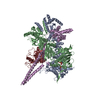
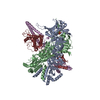
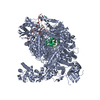

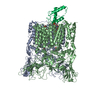

 PDBj
PDBj




























